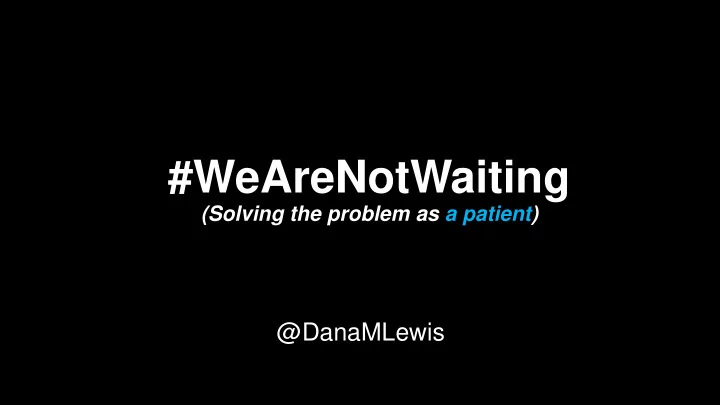

#WeAreNotWaiting (Solving the problem as a patient) @DanaMLewis
Getting diagnosed with a chronic disease is like being struck by lightning. @DanaMLewis
Food, hormones, sickness, stress Insulin, exercise, sickness, stress @DanaMLewis
The current tools are not perfect…. Continuous Glucose Monitor (CGM) Insulin Pump @DanaMLewis
Leaving us often with this:
If we can’t change existing devices… what if we could add *new* tools? @DanaMLewis
From reactive to predictive: an “open loop” @DanaMLewis
We already have in our pockets the tools needed for an “artificial pancreas”. @DanaMLewis
Components of an open source artificial pancreas • Continuous glucose monitor • Insulin pump @DanaMLewis
Components of an open source artificial pancreas 1. Continuous glucose monitor 2. Computer (“controller”) 3. Battery 4. Radio stick (“translator”) 5. Insulin pump @DanaMLewis (Illustration by Clint Ford for Popular Science)
Manual diabetes: 3. Do math about what 4. Give more/less action is needed insulin, or eat food 2. Read data from pump 1. Read data from CGM 5. Do it again.. and again... and again... @DanaMLewis
Automated diabetes: 3. Do math about what action is needed 4. Give more/less insulin Computer 2. Read data from pump 1. Read data from CGM 5. Do it again.. and again... and again... (human doesn’t have to pay constant attention, but still @DanaMLewis checks in from time to time)
Before: Aft fter:
(insulin pump) OpenAPS “rig” @DanaMLewis www.OpenAPS.org (continuous glucose monitor)
Do-It-Yourself (DIY) Building, making, or combining disparate tools into a solution that works for yourself. Often done when no commercial solution exists; or commercial solutions are not accessible; or because commercial solutions are not good enough to meet the needs of the individual. @DanaMLewis
#OpenAPS is an open and transparent effort to make safe and effective basic Artificial Pancreas System (APS) technology widely available to reduce the burden of Type 1 diabetes. @DanaMLewis
#OpenAPS : Taking the DIY, artificial pancreas from (n=1) to (n=1)*many by: • Focusing on safety • Limiting dosing ability in hardware and software • Using same dosing calculations a person would use • Responding (or not) to unexpected data • Tolerating communication failures • Failing back safely to standard device operation Reference design, code, documentation at OpenAPS.org
There are now ( n=1 ) *916+ people with DIY closed loops in the world. (That’s something like 7,000,000+ hours of DIY closed loop experience.) @DanaMLewis
Sustained improvements in average BG @DanaMLewis #2018ADA
@sulka script assessing changes in treatments https://github.com/sulkaharo/oref0-tools 2018: Pre-OpenAPS: 0.7 manual 4.5 manual interventions/ interventions/ day day (85% reduction) @DanaMLewis #2018ADA
@jb jbwittmer on QOL improvements of f #OpenAPS: • Annual School Nurse visits • 4 th grade - before OpenAPS -- 420 visits (2.3/day) • 354 “routine” visits for pre -lunch or pre-gym checks and decisions • 66 visits for hypo- or hyper-glycemic events • 6 th grade - with OpenAPS – 5 visits (0.027/day) • 3 gym-class associated hypoglycemic events • 2 equipment malfunction (CGM/OpenAPS rig)
Not traditional.. .. But yet we are: • Engineers • Engineers • Programmers • Developers • Scientists • Scientists • Researchers • Researchers • Rocket Scientists • Inventors @DanaMLewis
(M (Me, , anyt ytime someone says “but you’re not a _______”.) @DanaMLewis Flickr: @gumuz
Make sure patient-centered research is actually patient-centered 1. Involve patients at every step – from design to contextualizing results appropriately. 2. Don’t fall into the imposter syndrome/patient syndrome trap: med device Imposter syndrome: What people think patients know: co’s pharma government What people What we think patients know What patients know actually know insurers caregivers What we think everyone What people think else knows ”professionals” know HCPs researchers @DanaMLewis
Traditional innovation @DanaMLewis
How companies approach solutions: How patients approach @DanaMLewis solutions
How might the world change if we leverage these collective innovations that happen every day? @DanaMLewis
What happens when we enable patients to prioritize what we research and design solutions around? @DanaMLewis
What happens when we surface and share data openly so anyone – regardless of “role” or credentials – can use it to improve things? @DanaMLewis
What if we all say #WeAreNotWaiting to change the world like this? @DanaMLewis
# WeAreNotWaiting to change the future of healthcare. But we can do it faster, together. Will you help us? #OpenAPS | @DanaMLewis | www.DIYPS.org | www.OpenAPS.org
Recommend
More recommend